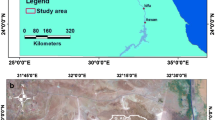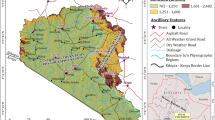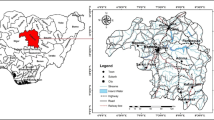Abstract
Systematic planning for groundwater exploration using modern techniques is essential for the proper utilization, protection and management of this vital resource. Enhanced Thematic Mapper Plus (ETM+) images, a geographic information system (GIS), a watershed modeling system (WMS) and weighted spatial probability modeling (WSPM) were integrated to identify the groundwater potential areas in the Sinai Peninsula, Egypt. Eight pertinent thematic layers were built in a GIS and assigned appropriate rankings. Layers considered were: rainfall, net groundwater recharge, lithology or infiltration, lineament density, slope, drainage density, depth to groundwater, and water quality. All these themes were assigned weights according to their relative importance to groundwater potentiality and their corresponding normalized weights were obtained based on their effectiveness factors. The groundwater potentiality map was finally produced by WSPM. This map comprises five gradational groundwater potentiality classes ranging from very high to very low. The validity of this unbiased GIS-based model was tested by correlating its results with the published hydrogeological map of Egypt and the actual borehole yields, where a concordant justification was reached. The map declared that the Sinai Peninsula is generally of moderate groundwater potentiality, where this class encompasses an area of 33,120 km2 which represents 52% of its total area.
Résumé
Un programme méthodique d’exploration des eaux souterraines utilisant des techniques modernes est essentiel à l’utilisation rationnelle, à la protection et à la gestion de cette ressource vitale. L’imagerie Enhanced Thematic Mapper Plus (ETM +), un système d’informations géographiques (SIG), un modèle de contour des bassins versants et un modèle de pondération spatiale probabiliste (WSPM) ont été intégrés pour identifier les zones de potentiel en eau souterraine de la Péninsule du Sinaï, Egypte. Huit couches thématiquement homogènes ont été incorporées dans un SIG et dotées d’indices appropriés. Les couches prises en considération sont : la hauteur des précipitations, la recharge nette en eau souterraine, la lithologie ou l’infiltration, la densité des linéaments, la pente, la densité de drainage, la profondeur de la nappe et la qualité de l’eau. Tous ces paramètres ont été pondérés selon l’importance relative qu’ils ont dans le potentiel en eau souterraine et la pondération normalisée correspondante basée sur leurs facteurs d’efficacité. La carte du potentiel en eau souterraine a été finalement établie avec le modèle WSPM. Elle est construite avec une échelle de 5 classes de potentiel en eau souterraine, allant de très fort à très faible. La validité de ce modèle rationnel basé sur SIG a été testée en comparant ses données avec la carte hydrogéologique d’Egypte publiée et les débits réels des forages, avec une concordance satisfaisante. La carte montre que, dans l’ensemble, la Péninsule du Sinaï dispose d’un potentiel moyen en eau souterraine, cette classe de potentiel couvrant une aire de 33,120 km², qui représente 52% de la surface totale.
Resumen
La planificación sistemática de la exploración de agua subterránea usando técnicas modernas es esencial para la adecuada utilización, protección y manejo de este recurso vital. Se integraron imágenes mejoradas del Thematic Mapper Plus (ETM+), un sistema de información geográfica (GIS), un sistema de modelado de cuenca (WMS) y un modelado de probabilidad espacial ponderado (WSPM) para identificar las áreas potenciales de agua subterránea en la Península de Sinaí, Egipto. Se ejecutaron ocho capas temáticas pertinentes en un GIS y se le asignaron rangos apropiados. Las capas consideradas fueron: lluvias, recarga neta de agua subterránea, litología o infiltración, densidad de lineamientos, pendientes, densidad de drenaje, profundidad del agua subterránea, y calidad del agua. A todos estos temas se le asignaron pesos de acuerdo con su importancia relativa a la potencialidad del agua subterránea y se obtuvieron sus correspondientes pesos normalizados basados en sus factores de efectividad. El mapa de potencialidad de agua subterránea fue finalmente producido por WSPM. Este mapa comprende cinco clases gradacionales de potencialidad de agua subterránea, de muy alta a muy baja. La validez de estos modelos de GIS no sesgados fueron testeados correlacionando sus resultados con los mapas hidrogeológicos publicados de Egipto y los rendimientos reales de las perforaciones, donde se alcanzó una justificación concordante. El mapa declaró que la Península de Sinaí es generalmente de moderada potencialidad de agua subterránea, donde esta clase abarca un área de 33,120 km2 que representa 52% de su área total.
الملخص
للحماية المناسبة، واستغلال وإدارة هذا المورد الحيوي. فبإستخدام صور القمر الصناعي الأمريكي المحسنة، ونظم المعلومات الجغرافية، تم إجراء نظام نمذجة متكامل يشمل نمذجة لمستجمعات المياه ونظام نمذجة الإحتمالية المرجحة المكانية لتحديد تواجدات المياه الجوفية في شبه جزيرة سيناء، مصر. وقد بنيت ثمانية طبقات ذات الصلة بهذا الموضوع في نظام معلومات جغرافي وتعيين الرتب المناسبة لها. والطبقات المختارة هي: هطول الأمطار، وصافي تغذية المياه الجوفية، الخصائص الصخرية والإرتشاح السطحي، وكثافة الشروخ، درجة الميل السطحي، وكثافة شبكة التصريف، والعمق حتى سطح المياه الجوفية، ونوعية المياه. وقد أعطيت جميع هذه الطبقات الموضوعية أوزان معينة وفقا لأهميتها النسبية في تحديد احتمالية تواجد المياه الجوفية وهي الأوزان التي تم الحصول عليها على أساس عوامل فعاليتها في عملية التحديد. وقد أنتجت خريطة إمكانية تواجد المياه الجوفية عن طريق تقنية النمذجة الوزنية للإحتمالية المكانية. هذه الخريطة تضم خمسة فئات لمناطق إحتمالية تواجد المياه الجوفية بتدرجات تتراوح مابين العالية جدا إلى المنخفضة للغاية. تم اختبار صحة هذا النموذج القائم على نظم المعلومات الجغرافية غير المتحيز خلال ربط نتائجه ومقرانتها بالخريطة الهيدروجيولوجية لمصر والإنتاجية الفعلية للأبار المنتجة، حيث تم التوصل إلى نتيجة عالية تبرر تطابق هذا النموذج على أرض الواقع. وأعلنت هذه الخريطة أن شبه جزيرة سيناء تتصف عموما بفئة معتدلة (متوسطة) من امكانات المياه الجوفية، حيث تشغل هذه الفئة مساحة قدرها 33120 كيلومتر مربع والتي تمثل 52 ٪ من مساحتها الكلية
Resumo
A planificação regular para a exploração dos recursos de água subterrânea utilizando técnicas modernas é essencial para a utilização, protecção e gestão adequada deste recurso vital. Imagens de satélite Landsat ETM + (Enhanced Thematic Mapper Plus), um sistema de informação geográfica (SIG), um programa de modelação de bacias (WMS) e um programa de modelação espacial de probabilidades ponderadas (WSPM) foram integrados para identificar as áreas com potenciais recursos de água subterrânea na Península do Sinai, Egipto. Foram seleccionados oito temas relevantes e integrados num suporte SIG, atribuindo-se-lhes as respectivas ponderações adequadas. Os temas considerados foram: precipitação, recarga subterrânea bruta, litologia ou infiltração, densidade de alinhamentos, declive, densidade de drenagem, profundidade da água subterrânea e qualidade de água. A cada um destes temas foi atribuído um peso ponderado de acordo com a sua importância para determinar os potenciais recursos de água subterrânea e os seus pesos normalizados correspondentes foram obtidos com base na efectividade dos seus factores. Um mapa do potencial dos recursos de água subterrânea foi finalmente produzido utilizando o WSPM. Este mapa inclui cinco classes que resumem o potencial dos recursos de água subterrânea, variando de muito elevado a muito reduzido. A validade deste modelo imparcial com suporte SIG foi testada realizando uma correlação entre os resultados obtidos da sua aplicação, o mapa hidrogeológico do Egipto e as produtividades das captações, verificando-se a concordância dos resultados. O mapa indica que a Península de Sinai tem recursos de água subterrânea com um potencial moderado, sendo que esta classe corresponde a uma área de 33,120 km2, o que representa 52% da área total.







Similar content being viewed by others
References
Abd El Rahman H (2001) Evaluation of groundwater resources in Lower Cretaceous aquifer system in Sinai. Water Resour Manage 15(3):187–202
Abu Rayan M, Djebedjian B, Khaled I (2001) Water supply and demand and a desalination option for Sinai, Egypt. Desalination 136:73–81
AQUAVEO (2008) Water modeling solutions. Support forum for watershed modeling system software (WMS). www.aquaveo.com. Cited August 2009
Becker D, Sultan M, Becker R, Milewski A, Soliman F, Abdeldayem AW, Balekai R, Rashed M (2007) An integrated approach for the assessment of the renewable ground water resources of Sinai, Egypt. Geol Soc Am Abst 39(6):482
Chen Cl (1982) An evaluation of the mathematics and physical significance of the soil conservation service curve number procedure for estimating runoff volume. In: Singh VP (ed) Rainfall–runoff relationship. Water Resources, Littleton, CO, pp 487–515
CONOCO (Continental Oil Company) (1987) Geological Map of Egypt (Scale 1: 500,000). Conoco Inc., Ogden, UT, in collaboration with Freie Universitat Berlin, Berlin, Germany
Das D (2000) GIS application in hydrogeological studies. Available via www.gisdevelopment.net. Cited August 2009
De Roo APJ (2000) Applying the LISEM model for investigating flood prevention and soil conservation scenarios in South-Limburg, The Netherlands. In: Schmidt J (ed) Soil erosion: application of physically based models. Springer, Heidelberg, 318 pp
Degnan P, Clark H (2002) Fractured-correlated lineaments at Great Bay, southeastern New Hampshire. US Geol Surv Open-File Rep 02-13, 14, 1 plate
Doll P, Lehner B, Kaspar F (2002) Global modeling of groundwater recharge. 399 Proceedings of 3rd International Conference on Water Resources and the Environment Research, vol 1. Technical University of Dresden, Germany, pp 27–33
Edet A, Okereke S, Teme C, Esu O (1998) Application of remote sensing data to groundwater exploration: a case study of the Cross River State, southeastern Nigeria. Hydrogeol J 6(3):394–404
El-Baz F (1992) Preliminary observations of environmental damage due to the Gulf War. Nat Resour Forum 16(1):71–75
El-Baz F et al. (1992–1995) Research project. Groundwater potential of the Sinai Peninsula, Egypt. http://www.bu.edu/remotesensing/research/completed/egypt-groundwater/. Cited June 2010
El-Shazly EM, Abdel Hady MA, El Ghawaby MA, Salman AB, El Rakaiby MM, El Aasy IE (1980) Structural lineation maps of Sinai, scale 1:250, 000. Academy of Scientific Research and Technology, Remote Sensing Center, Cairo
El-Shazly M, El Rakaiby M, El Kassas M (1983) Groundwater investigation of Wadi Araba area, Eastern Desert of Egypt, Using Landsat Imagery. Proc. 17th Symp. on Remote Sensing of the Environment. Ann Arbor, MI, 9–13 May 1983, pp1003–1113
El-Shazly EM, Mohamed SS, Abd Alatif TA, Misak R, Mabrouk MA (1985) Groundwater potential of St Catherine Monastery Environs, Sinai, Egypt. J Geol 11:89–100
ESRI (2007) ArcGIS 9.2 Software and user manual. Environmental Systems Research Institute, Redlands, CA. http://www.esri.com. Cited June 2009
Fetter CW (1994) Applied hydrogeology, 3rd edn. Prentice Hall, Upper Saddle River, NJ, 691 pp
Garbrecht J, Martz LW (1997) TOPAZ: an automated digital landscape analysis tool for topographic evaluation, drainage identification, watershed segmentation and subcatchment parameterization; TOPAZ Overview, USDA, ARS Publication no. GRL 97-3, Agricultural Research Service, Grazing lands Research Laboratory, El Reno, OK
Gheith H, Sultan M (2000) Assessment of the renewable ground water resources of Sinai, Egypt using remote sensing, digital terrain elevation, and meteorological data. Symposium of Remote Sensing and Hydrology 2000, International Commission on Remote Sensing for Hydrology, Santa Fe, NM
Gheith H, Sultan M (2001) Assessment of the renewable groundwater resources of Wadi El-Arish, Sinai, Egypt: Modeling, remote sensing and GIS applications. In: Owe M et al. Proc. of a Symposium on Remote Sensing and Hydrogeology. IAHS Publ. 267, IAHS, Wallingford, UK, pp 451–454
Hjelmfelt AT Jr (1980) Curve-number procedure as infiltration method. J Hydraul Div ASCE 106:1107–1111
Hogarth WL, Rose CW, Parlange JY, Sander GC, Carey G (2004) Soil erosion due to rainfall impact with no inflow: a numerical solution with spatial and temporal effects of sediment settling velocity characteristics. J Hydrol 294:229–240
Holtan HN (1961) A concept for infiltration estimates in watershed engineering. USDA Agricultural Research Service Publication: ARS-41-51, USDA, Agricultural Research Service, Grazing lands Research Laboratory, El Reno, OK
Horton RI (1938) The interpretation and application of runoff plot experiments with reference to soil erosion problems. Proc Soil Sci Soc Am 3:340–349
ICG (International Crisis Group) (2007) Egypt’s Sinai question. Middle East/North Africa Report no. 61, ICG, Brussels, 32 pp. www.ciaonet.org/wps/icg431/icg431.pdf. Cited June 2009
Isaaks EH, Srivastava RM (1989) An introduction to applied geostatistics. Oxford University Press, New York, 561 pp
Issar AS, Bein A, Michaeli A (1972) On the ancient water of the Upper Nubian sandstone aquifer in central Sinai and southern Israel. J Hydrol 17:353–374
Jain MK, Kothyari UC, Ranga Raju KG (2005) Geographic information system based distributed model for soil erosion and rate of sediment outflow from catchments. J Hydraul Eng ASCE 131(9):755–769
JICA (Japan International Cooperation Agency) (1999) South Sinai groundwater resources study report. Pacific Consultants International and Sanyu Consultants Inc., Tokyo
Kusky T, El-Baz F, Morency R, Himida I (1994) Remote sensing aids to groundwater exploration in fractured rocks of the Sinai Peninsula. Harvest 1:3–4
Leica Geosystems GIS, Mapping LLC (2008) ERDAS Field Guide, vol 1. Leica Geosystems Geospatial Imaging, Norcross, GA
MASOUD A, Koike K (2005) Remote sensing and GIS integration for groundwater potential mapping in Sinai Peninsula, Egypt. Proceedings of International Association for Mathematical Geology (IAMG’05): GIS and Spatial Analysis, vol 1, 21–26 Aug 2005, Toronto, pp 440–445
Milewski A, Yan E, Sultan M, Abdeldayem AW, Gelil KA, Becker R, Markondiah Jayaprakash S (2006) A catchment based hydrologic model for the Sinai Peninsula using remote sensing and field datasets, EOS Trans AGU, 87(36), Jt. Assem. Suppl., Abstract H43B-11
Mills AC, Shata A (2009) Ground-water assessment of Sinai, Egypt. Groundwater 27(6):793–801
Mishra S K, Singh V P (2003) Soil Conservation Service Curve Number (SCS-CN) Methodology. Kluwer, Dordrecht, The Netherlands, pp 2–4
Mishra SK, Singh VP (2004a) Validity and extension of the SCS-CN method for computing infiltration and rainfall-excess rates. J Hydrol Process 18:3323–3345
Mishra SK, Singh VP (2004b) Long term hydrological simulation based on the soil conservation service curve number. J Hydrol Process 18(7):1291–1313
Moore G, Waltz FA (1986) Objective procedure for lineament enhancement and extraction. Photogramm Eng Rem Sens 49:641–647
Ponce VM, Hawkins RH (1996) Runoff curve number: Has it reached maturity? Hydrol Eng ASCE 1(1):11–19
RIGW (Research Institute for Groundwater) (1999) Hydrogeological map of Egypt. Scale 1:2,000,000, 2nd edn. National Water Research Center (NWRC), Ministry of Public Works and Water Resources, Cairo
Robinson C, El-Baz F, Singhory V (1999) Subsurface imaging by RADARSAT: comparison with Landsat TM data and implications for groundwater in the Selima area, northwestern Sudan. Rem Sens Abst 25(3):45–76
SCS (1956) National Engineering Handbook, Hydrology, sec. 4. Soil Conservation Service, USDA, Washington, DC
Sener E, Davraz A, Ozcelik M (2005) An integration of GIS and remote sensing in groundwater investigations: a case study in Burdur, Turkey. Hydrogeol J 13(5):826–834
Shata A (1956) Structural development of the Sinai Peninsula, Egypt. Bull de L’ Inst. Desert. d’ Egypt, Cairo
Shata A (1992) Watershed management, development of potential water resources and desertification control in Sinai. Proceedings of the 3rd Conference on the Geology and Development of Sinai, Ismailia, Egypt, Dec. 2007, pp 273–280
Smith SE, El-Shamy I, Abd-El Monsef H (1997) Locating regions of high probability for groundwater in the Wadi EI-Arish Basin, Sinai, Egypt. J Afr Earth Sci 25(2):253–262
Teeuw R (1995) Groundwater exploration using remote sensing and a low-cost geographic information system. Hydrogeol J 3(3):21–30
Tucker GE, Bras RL (1998) Hill slope processes, drainage density, and landscape morphology. Water Resour Res 34:2751–2764
Tyagi JV, Mishra SK, Singh R, Singh VP (2008) SCS-CN based time-distributed sediment yield model. J Hydrol 352:388–403
UNDP (United Nations Development Program)/GEF funded project (2003–2008), Renewable groundwater resources in Sinai. UNDP, New York. http://www.esrs.wmich.edu/htm/sinai_water.html. Cited June 2010
Van Engelen VWP, Wen TT (1995) Global and national soils and terrain digital databases (SOTER). Procedures manual (revised edn.). International Soil References and Information Centre, Wageningen, The Netherlands
Acknowledgments
This study was supported and funded by the National Authority for Remote Sensing and Space Sciences (NARSS), Cairo, Egypt. We thank the North Sinai Information Center for providing access to the up-to-date unpublished water resources reports. The authors are grateful for the thorough reviews by Dr. Shemin Ge (Editor) and Sue Duncan (Technical Editorial Advisor) of Hydrogeology Journal and the anonymous reviewers. Their comments significantly improved the quality of the paper.
Author information
Authors and Affiliations
Corresponding author
Rights and permissions
About this article
Cite this article
Elewa, H.H., Qaddah, A.A. Groundwater potentiality mapping in the Sinai Peninsula, Egypt, using remote sensing and GIS-watershed-based modeling. Hydrogeol J 19, 613–628 (2011). https://doi.org/10.1007/s10040-011-0703-8
Received:
Accepted:
Published:
Issue Date:
DOI: https://doi.org/10.1007/s10040-011-0703-8




